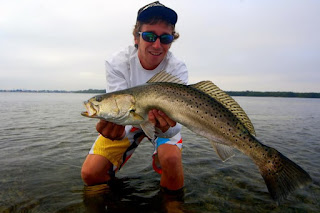Vital Fly Skills That Every Seadrift Texas Fishing Fanatic Must Master For Successful Trout Hunt
All through Seadrift Texas, trout fishes behave in the
similar manner. How, when, what and where these fishes will feed is very easily
predictable. For every Seadrift
Texas fishing enthusiast mastering how to catch trouts on a fly rod goes
beyond basically understanding where to find the fish exactly.
Scroll the key fly skills outlined below to get you all
primed and prepared for each aspect of the trout fishing game.
Master the Following Fly
Skills For Successful Trout Hunt in Seadrift Texas:
- Learn to Read Texas Waters:
This is one of the most vital skills for many experienced Seadrift fishing guides and passionate
river anglers in Texas. Do you know what a riffle, eddy, tailout, run, and pool
is? Learn and master what a tailout, run, riffle, eddy, tailout and pool is because
trouts make use of these spots for several different reasons and shift from one
to another at different seasons of year and times of day. Trout are very lazy and
make use of eddies, rocks and currents to hide in waylay and patiently wait for
food. Focus to where exactly you saw the last fish eat and for what reason the
fish have been there. Speak with the fellow anglers and ask where exactly they
have been catching trouts. Just keep calm and watch the Texas waters.
- Learn Trout Food Preferences:
Trouts focus on feeding the water insects, small baitfish
and crustaceans. Understand the life cycle of the primary aquatic insects and
you can then easily catch more trouts quickly. They are midges, mayflies,
caddisflies and stoneflies. The land-based insects such as grasshoppers,
beetles and ants are also vital food sources for trouts, particularly in the
late summer and early fall as they are more abundant in comparison to the water-born
insects.
- Never Hunt Trouts under Pressure:
Once the fishing
fanatics in Seadrift Texas hook a big fish you must avoid landing it
quickly. While you are dealing with a big fish or heavy current, you must keep
a balance between a secure fight time and smart fighting approach. Let trouts run
a little as putting the pressure on the fish too early will surely make you
lose it. Practice making use of a 45 degree angle or less with the fly rod and try
keeping your tip high, enabling the rod soak up all the pressure. Once the trouts
gets closer and more exhausted, transfer the rod to the sideways angle, raise
pressure and pull the fish in speedily.
- Wade Only If Required:
Nearly every Seadrift Texas
based fishing enthusiast feels guilty about getting too excited as they get
into the river and wading right away to that initial juicy run. By doing this
the anglers spooked the trouts between that run. Keep your jets cool slightly as
you hit the river. As you freeze your sights on a key piece of water, hunt your
way to it rather than wading right to it.
- Stay Cautious & Patient:
Once you spot a feeding trout never immediately cast to it. Just stay
calm, still, patient and quiet to observe what it is doing for a moment. Monitor
the timing of the fish’s eats above or below the water and then drop the fly at
the right time.
- Hunt Downstream:
One of the most significant reasons to hunt downstream is encountering complex
currents which won’t let you to get a drag free flow of your bugs from
upstream. When this happens, just give the trout’s lie a broad birth while you stride
upstream and cast way above the trout through a slack line cast. Stop the fly
rod at the end of the cast and provide a slight wiggle that will throw elbows or
curves into your line, enabling it drift drag-free inside the trout’s face.
For some or the other reason the above mentioned fly skills
might be hard for a few Seadrift Texas fishing enthusiasts to master, but it
can definitely assist your fish hunting in a major way.
Stay vocal with other trout anglers or fishing
guides in Seadrift and provide a
wide birth. It is not at all about getting nosey, rather it is about amplifying
your odds of better trout fishing and everyone will surely have a better day
fishing experience.










Comments
Post a Comment